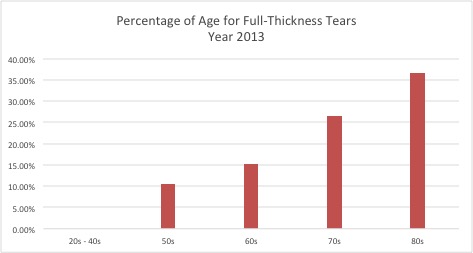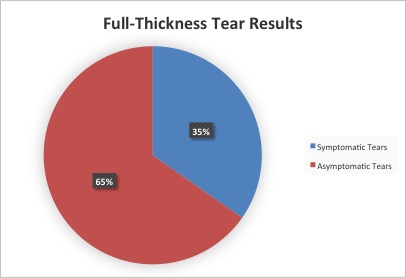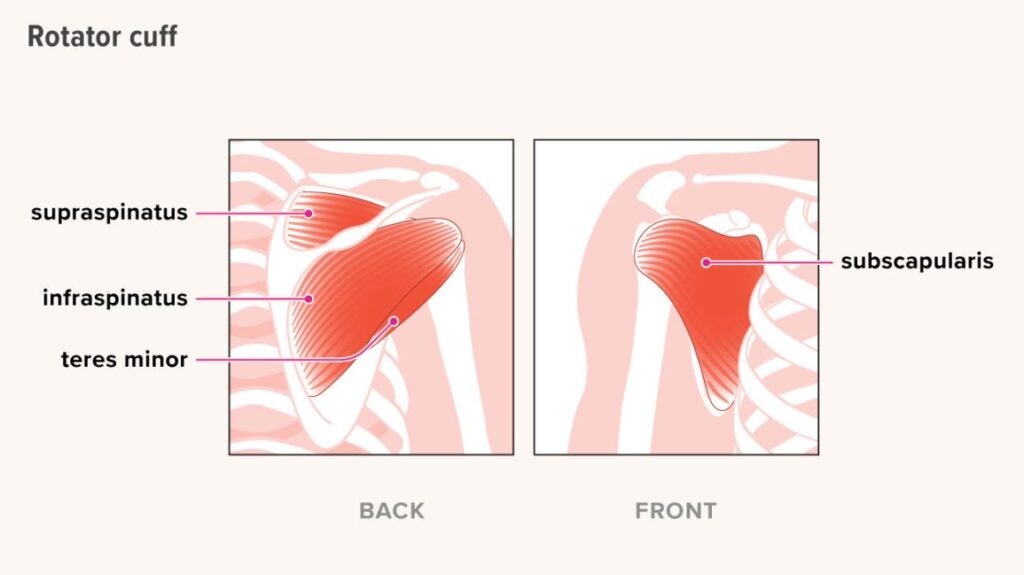ROTATOR CUFF PAIN
The rotator cuff is a group of muscles located in the shoulder area. It keeps the shoulder and the head of the upper arm intertwined and firm by extending muscles and tendons around it. Rotator cuff pain mostly occurs because of rotator cuff injuries, which lead to a discomfort in the shoulder area. The sensation increases the more the person uses their arm and rotates it.
A clear description of the injury that leads to rotator cuff pain is a torn tendon. When one or many tendons get detached from the head of the upper arm, also called the humerus, this is when rotator cuff pain begins. It does not tear right away; however, the tendon gradually begins to fray. But, if the person does not change their lifestyle and starts to treat it, it tears completely. Other parts of the rotator cuff might also lead to this injury, but torn tendons are the number one cause of it.
There are two types of tears:
- Partial tear: This is not a complete tear; on the contrary, it is incomplete, and it only damages the tendon without severing it completely.
- Full-thickness tear: This tear is a complete one. It will lead to a full separation of the tendon and the bone leading to a hole in the tendon that needs immediate treatment.
A study was done on 664 people, in order to determine the reason behind their rotator cuff pain. 147 people out of 664 showed a full-thickness tear in their rotator cuff. Among those 147, 51 people showed symptoms, while 96 were asymptomatic.
Rotator cuff pain is very common and occurs mostly in elderlies because of the overuse of their arms and shoulders. The results of the previous study are shown in the graph below.
“Each year, almost 2 million people in the United States visit their doctors because of a rotator cuff problem.” (OrthoInfo, 2017). It is also very common for people whose jobs require them to use their hands and shoulders a lot, like tennis players and painters for example.
People with rotator cuff should go see a doctor in order to have a proper diagnosis of their injury, but sometimes people can handle the symptoms and just stick to rest and physical therapy exercises which lead to a more flexible and strong shoulder muscle. But at other times, rotator cuff pain comes from a more extreme injury and will not only heal by rest; it will need a more intense medical intervention or even surgery to fix the tear. This pain leads to the weakness of the shoulder and stops the person from doing any normal daily activity such as getting dressed or moving a chair (OrthoInfo, 2017).


WHAT ARE THE CAUSES OF ROTATOR CUFF PAIN?
Rotator cuff pain happens mostly because of two factors. It is either the result of a substantial injury to the shoulder, or because of a tendon tissue tear that results after the tendon progressively degenerates from too much usage and heavy lifting for a long period of time.
- Rotator cuff injury, also known as acute tear:
The types of injuries that lead to rotator cuff pain vary from shoulder injuries, which lead to a dislocated shoulder, to collarbone injuries. These occur when a person either falls down on his outstretched arm or when a person lifts something too heavy and tears his rotator cuff. - Degeneration, also known as degenerative tear:
Degenerative tears occur mostly with adults and older individuals. It happens over time when the shoulder muscles and tendons have been used a lot naturally as the person ages. To add, if one shoulder suffers from a degenerative tear, it is very likely that the other shoulder’s rotator cuff will also suffer from a tear. But scientists have proven that dominant arms are most likely to cause rotator cuff degenerative tears (OrthoInfo, 2017).
Many factors lead to the increase of degenerative tears, including:
- Daily stress: When we mention stress here, we do not mean the personal stress that comes when one is feeling overwhelmed. We are rather talking about the stress of the rotator cuff muscles and tendons that occurs when the shoulder repeats the same movements and motions every day. Some jobs and sports lead to degenerative tears more often than others like baseball, tennis, and weightlifting for example.
- Lack of blood supply: As one gets older, the blood supply is no longer sufficient in all parts of the body. The rotator cuff is one of these places where the blood supply lessens as the person gets older. In this case, when a tendon in the rotator cuff becomes damaged, the body loses the immunity and the blood supply which are needed to repair it, leading to its degenerative tear.
- Bone overgrowth: Bone overgrowth, also known as bone spurs, happens when a person becomes older. It leads to a development of a bone in the underside of the acromion. After the growth of this bone, each time the person lifts their arms; it will start to rub on the rotator cuff tendon leading to a weaker tendon that is very likely to tear. According to OrthoInfo (2017), this condition is called shoulder impingement.

WHAT ARE THE SYMPTOMS OF ROTATOR CUFF PAIN?
The rotator cuff pain is usually described as a dull ache deep in the shoulder area that makes day to day activities more difficult like reaching behind your back for instance. It leads to a weakness in the arm and disturbs the person while sleeping.
The symptoms of rotator cuff injuries are minimal at first and may be treated only with rest. But the pain and other symptoms usually become worse over time; they require more intense treatments in order for the pain not to become constant and for the symptoms not to go past the elbow, because this leads to a much greater problem.
Other symptoms include:
- A stiffness of the shoulder.
- Lack of sleep because the pain will make you wake up.
- A clicking or popping sound when raising your arm.
- Swelling in the front of the shoulder or the side of the arm.
- Pain each time you raise or lower your arm, and each time you reach behind your back.
- A loss of strength in the arm and shoulder.

HOW TO TREAT ROTATOR CUFF PAIN?
There are two types of treatments for rotator cuff pain; it’s either a surgical treatment or a non-surgical treatment.
- Surgical treatments:
The doctor will always recommend nonsurgical methods first for the patient, but once these treatments do not work out, surgery is necessary. Other reasons why the doctor might recommend surgery are: - If the patient is very active and overuses their arm on a daily basis, for instance professional tennis players.
- When the pain is constant.
- When the symptoms have been occurring for more than six months.
- When the tear in the tendon is too large to be fixed by nonsurgical methods (more than 3cm).
- When the weakness of the shoulder is extreme and the patient can no longer do basic chores.
- When an extreme injury occurs.
The types of surgeries differ based on the different causes and situations of each patient. There are four:
- Arthroscopic tendon repair: In this surgery, a small camera called an arthroscope is inserted with a surgeon’s tools through a small incision made on the shoulder to fix the torn tendon and reattach it to the bone.
- Open tendon repair: For this surgery, a larger incision is needed in order for the surgeon to be able to reattach the torn tendon to the bone.
Tendon transfer: In this surgery, the tendon is too torn to be reattached to the bone, meaning that the better solution is replacing it with a new tendon. - Shoulder replacement: This type of surgery is the most extreme one. It is only done when there is a massive rotator cuff injury. It improves the shoulder’s stability by installing the ball part of the artificial joint onto the shoulder blade and the socket part onto the arm bone. (Mayo Clinic, 2020)
- Nonsurgical treatments: According to Healthline (2018), “Nonsurgical treatments improve symptoms in about 50 percent of people with a rotator cuff injury.”
These treatments vary between:
- Rest: Rotator cuff pain is caused by muscle and tendon pain. The first way to treat it is through rest. Stopping any activities that might harm the shoulder more should also be avoided completely in order to not harm the shoulder even more.
- Non-steroidal anti-inflammatory medication: Anti-inflammatory medications are very highly recommended to people who suffer from this type of pain. They will help to reduce any type of swelling and pain and will prevent further possible inflammations.
- Physical therapy: Physical therapy helps the patient to strengthen his shoulder and increases flexibility to relieve further pain and injuries. A professional should be carefully helping the patient in order not to harm himself more.
- Steroid injection: This method is not highly recommended, but if all other non-surgical treatments do not help, injecting anesthetic and cortisone might help do the trick. They are another type of anti-inflammatory medicines and will also reduce swelling and pain.
If you or anyone you know is suffering from pain, call us today at (469) 545-9983.
